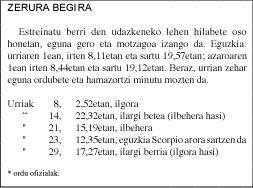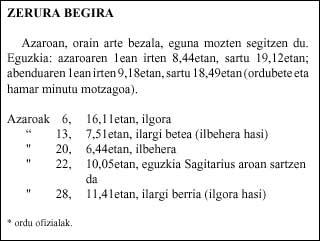Monthly plant magazine. June
1989/05/01 Errekondo Salsamendi, Jakoba Iturria: Elhuyar aldizkaria
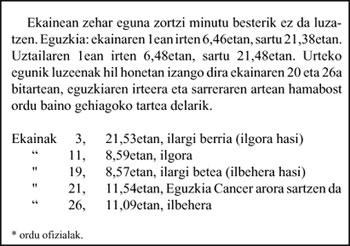
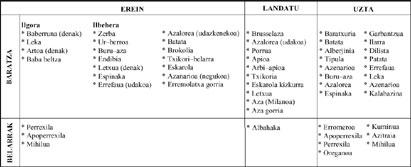
Special vegetables
In the section HUERTA, started some specimens, some unconventional vegetables are mentioned, which we consider of interest to diversify the varieties of vegetables that we produce in our fields and orchards. These are their descriptions and particularities.
Eggplant:
Solanum melongera. Harvest: fruit.
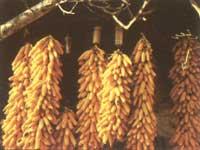
Annual cycle plant. Its needs are similar to tomato: light and well fertilized soil, supports organic fertilizers without curing and requires hot time.
- Sowing: in hot soil in February-March (1 gram = 250 seeds)
- Planting: in May, in protection or local calendar. 40-50 cm between plants and 70 cm between rows.
- Works: like the tomato, an initial pruning of all the pujal that is not the main arba (up to 30 cm) will be done leaving after 4 or 5 branches.
- Harvest: August-September-October.
Artichoke:
Cynara scolymus. Harvest: flower.
Getting a good harvest of artichoke is not an easy task, but it is worth it. He does not like the cold, but he likes the climate of the coast. It needs rich lands, especially in organic fertilizers.
- To plant: for reproduction of artichoke plants furniture which grow on a root neck is used. During the month of April, leaving a distance of 0.8 x 1 m, two hole sizes will be planted.
- Works: numerous weeds. In winter protect with straw, grass, etc. After harvest cut the whole plant to 30 cm. Protect yourself from attacks by sketchers and mole. Pay annually.
- Harvest: 10-25 flowers per plant in autumn. Every 3 years the plants are replenished, but up to 6 years a good yield can be obtained.
Celery:
Apium graveolens . Harvest:leaf.
Celery prefers a wet and cool weather, but without droughts or cold. Use of mature organic fertilizer.
- Erein: small seed (1g=2,000 seeds). In March-April sow unburied. Fatigue is very slow (about 3 weeks) and should always be kept moist.
- Planting: May-June-July. Distance 30 x 35 cm.
- Works: it is convenient to keep the soil moist for as long as possible. Before harvest it is advisable to whiten the birds to improve their quality. This work can be done in two ways: a binding the plant and surrounding it of everything that does not allow the passage of light (cardboard, etc.) and the other earth cover for ten days to the leaves on three occasions.
- Harvest: autumn and winter.
Celery turnip:
Apium graveolens rapaceum . Harvest: root.
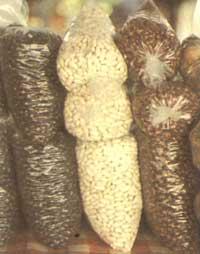
Celery has the same needs, but as the most important thing is root growth, fertilization in Potassium (K2O) and Phosphorus (P2O5) should be done with special care.
It is advisable to have a light (sandy) soil that does not hinder the growth of the root.
- Sowing: January-March, preferably in hot soil.
- Planting: about May (30 x 35 cm). Cut the side roots.
- Works: frequent and short irrigation.
- Harvest: from October. It is a well preserved root. For this, the one who has left the first land and, like the potato, pick up in a cool (2-3º) and dry place.
Pumpkin:
Cucurbita maxima and Cucurbita moschat. Harvest: fruit.
To bring your cycle to fruition you need a sunny and warm place. Therefore, we will place it in the most natural field. The soil needs a lot of organic fertilizer, even if it is not ripe.
The dungeon is a creeping or climbing plant. Since the fruits normally grow in contact with the earth's crust, a level ground will be needed to prevent the formation of ponds that would prune the fruits.
- Erein: March to May. Directly in the field.
- Works: it has a very superficial root system and suffers a lot from drought. Therefore, if irrigation does not allow good maintenance, it is advisable to cover the soil with a layer of organic waste. Realization of weeds that reinforce the development of superficial veins. The most common disease is oidium, which is treated with sulfur or organic compounds containing zinc. Plant louse among pests. Their attacks are not worrying.
- Harvest: October-November-December, before the first ice. In dry and ventilated areas it is usually preserved in winter.
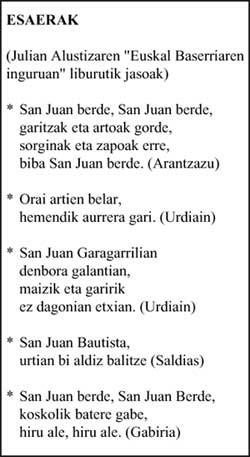

Gai honi buruzko eduki gehiago
Elhuyarrek garatutako teknologia



